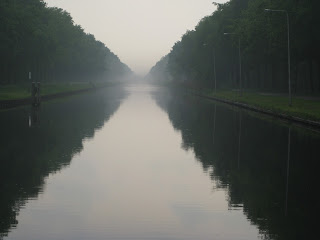 |
| Eltmann - Muhlhausen (using bikroutetoaster.com) |
As was becoming usual I woke up looking a complete mess, with swollen eyes from the hayfever reaction. Eyedrops and a wash usually made me look a little more presentable but I still wondered if I really looked like somebody who could actually cycle another 500 miles.
A good breakfast in the pension and then off along the next stretch of the Main Radweg. It was a beautiful morning and I made good time, averaging over 12 mph along the riverbank.
 |
| Lock on the River Main |
After an hour or so I arrived in Bamberg. This is a beautiful old town at the point where the River Main and the canal join.
 |
| Bamberg |
This time the tourist information office was very helpful and they explained to me how to find the Main-Donau Canal towards Nuremberg. I took time to push my bike through the pedestrianised centre of town where there was a large and bustling street market, with everyone selling asparagus and strawberries. I wondered if I would arrive in Budapest in time to catch its own strawberry season?
The canal towpath out of Bamberg started off as tarmac, but after a few miles gave way to good-quality gravel. However, the surface then deteriorated and I decided to follow the main road that runs parallel to the canal for a little while. This gave me the chance to buy some lunch in a Lidl, and as I set off again heading south I realise that the wind had shifted a little and that the easterly that had been pushing against me all week was now coming more from the north and that I now had a good tailwind. I sped along the road at over 15 mph.
At Forchheim I rejoined the canal and found that there was a good-quality gravel surface. With that and the tailwind I was able to speed along again and maintained a good 13-15 mph for the next hour or so until I stopped for lunch at one of the massive lock gates on the canal. Sitting there with my bread, hummus, tomato, bread and chocolate in the sunshine with a flat canal towpath ahead of me I felt pretty good again.
All through the afternoon I battered on down the canal apart from a brief detour around commercial premises at Erlangen. Nuremberg was next, and I passed its distinctive pylon as the canal took me through the outskirts of the city. I was rather worried about whether or not my tyres would cope with the gravel surface, and initially feared for punctures, but nothing happened and I just kept on going.
 |
| Barge heading down the Main-Donau Canal |
The feeling of hypnotism was magnified by the physical isolation of the canal. Occasionally I could see villages in the distance, but essentially I was travelling through empty countryside, surrounded by forests and big fields of green wheat. Occasionally a recreational cyclist would pass my way, but I did not see a single pannier-laden tourer.
At one point I could see in the very far distance a point of light, apparently moving towards me. After some minutes I realised it was another cyclist with a powerful front light and eventually we crossed. It reminded me of be seen in one of my favourite films, "Lawrence of Arabia", where Lawrence, sitting at a water hole, sees Omar Sharif appearing out of the desert haze, slowly getting bigger and bigger.
After some hours of this I realised that both the bicycle and myself were covered with a fine white dust, and again my thoughts drifted to Lawrence of Arabia. I imagined that after more hours of this that I would suddenly emerge on the Danube, and as in the film, a ship's funnel would suddenly appear above the embankment. But that would only happen when I reached the Danube, and I realised that by six o'clock I was becoming very tired and that I would need to stop for the night. Where roads crossed the canal the local villages had erected noticeboards advertising accommodation and at one of these I rang the Brunnerwirt Gasthof in Muhlhausen. They had a room available and I cycled the last few miles to get there.
I unloaded the bike and put it away in their lock-up garage and threw everything on the floor in my room. My evening routine, when finishing the ride for the day, was to lie on my back and pull my knees up towards my stomach, staying there reflecting on the magical stillness of that moment. After the non-stop intensity of cycling all day this was truly a wonderful few minutes.
 |
| The Rhine-Donau watershed (Rhine to the right!) |
The evening meal was very satisfying, helped by two glasses of Glossner Neumarkter beer, a particularly fine brew.
Up until today I had been cycling away from the North Sea but from tomorrow I would be cycling towards the Black Sea. I had now done 612 miles and was over half way to Budapest.

























